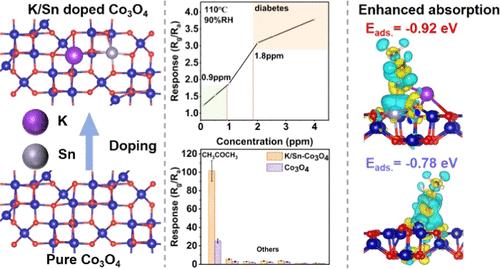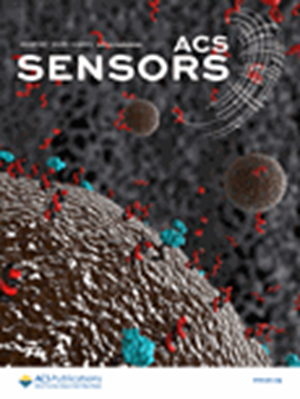Ultrasensitive Acetone Gas Sensor Based on a K/Sn–Co3O4 Porous Microsphere for Noninvasive Diabetes Diagnosis
IF 9.1
1区 化学
Q1 CHEMISTRY, ANALYTICAL
引用次数: 0
Abstract
The detection of acetone in human exhaled breath is crucial for the noninvasive diagnosis of diabetes. However, the direct and reliable detection of acetone in exhaled breath with high humidity at the parts per billion level remains a great challenge. Here, an ultrasensitive acetone gas sensor based on a K/Sn–Co3O4 porous microsphere was reported. The sensor demonstrates a detection limit of up to 100 ppb, along with excellent repeatability and selectivity. Remarkably, without the removal of water vapor from exhaled breath, the sensor can accurately distinguish diabetic patients and healthy individuals according to the difference in acetone concentrations, demonstrating its great potential for diabetes diagnosis. The enhanced sensitivity of the sensor is attributed to the increased oxygen adsorption on the material surface due to K/Sn codoping and the stronger coadsorption of Sn–K atoms to acetone molecules. These findings shed light on the mechanisms underlying the sensor’s improved performance.

基于 K/Sn-Co3O4 多孔微球的超灵敏丙酮气体传感器用于无创糖尿病诊断
检测人体呼出气体中的丙酮对于糖尿病的无创诊断至关重要。然而,如何在十亿分之一的高湿度环境中直接可靠地检测呼出气体中的丙酮仍然是一个巨大的挑战。本文报告了一种基于 K/Sn-Co3O4 多孔微球的超灵敏丙酮气体传感器。该传感器的检测限高达 100 ppb,同时具有出色的重复性和选择性。值得注意的是,在不去除呼出气体中水蒸气的情况下,该传感器能根据丙酮浓度的差异准确区分糖尿病患者和健康人,这证明了它在糖尿病诊断方面的巨大潜力。传感器灵敏度的提高归因于 K/Sn 共轭作用增加了材料表面对氧的吸附,以及 Sn-K 原子对丙酮分子的共吸附作用更强。这些发现揭示了传感器性能提高的内在机制。
本文章由计算机程序翻译,如有差异,请以英文原文为准。
求助全文
约1分钟内获得全文
求助全文
来源期刊

ACS Sensors
Chemical Engineering-Bioengineering
CiteScore
14.50
自引率
3.40%
发文量
372
期刊介绍:
ACS Sensors is a peer-reviewed research journal that focuses on the dissemination of new and original knowledge in the field of sensor science, particularly those that selectively sense chemical or biological species or processes. The journal covers a broad range of topics, including but not limited to biosensors, chemical sensors, gas sensors, intracellular sensors, single molecule sensors, cell chips, and microfluidic devices. It aims to publish articles that address conceptual advances in sensing technology applicable to various types of analytes or application papers that report on the use of existing sensing concepts in new ways or for new analytes.
 求助内容:
求助内容: 应助结果提醒方式:
应助结果提醒方式:


